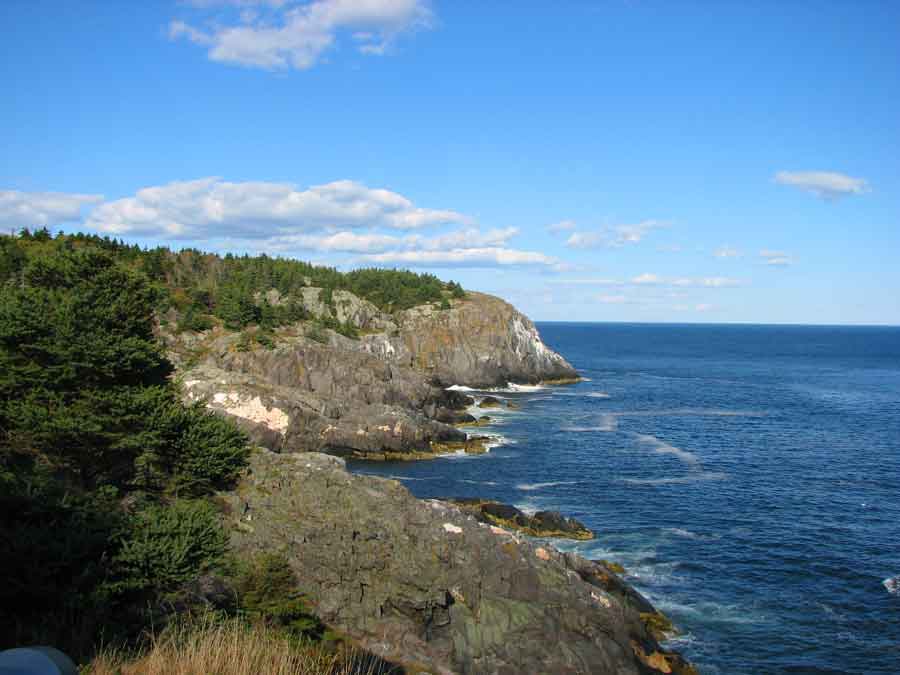Monhegan

Monhegan Island is the destination for many commercial tour companies. It is a famous migrant trap, as the birds often descend into the trees and shrubs of the village itself, feeding voraciously and ignoring the closest observers. The village is confined to the western side of the island. The eastern side is a dramatic series of cliffs and coves. Though the island is only one square mile in size, 17 miles of interwoven trails crisscross it. It is possible to sit on any of the cliffs and scan for passing Northern Gannets, and perhaps Parasitic or Pomarine Jaegers. Breeding Common Eiders and Black Guillemots surround the island. Laughing Gulls mix with the Herring and Great Black-backed Gulls. Peak birding occurs during the last three weeks of May and from late August through early October.
At peak migration, a morning might turn up twenty different species of warbler. Sharp-shinned Hawks, American Kestrels, Merlins, and Peregrine Falcons follow coastal migration routes and often touch down on the island. Out-of-range species are a common occurrence.
Before heading for the cliffs, spend plenty of time in the village. Most of the wandering passerines are found in town among the ornamental trees and shrubs. Venture down to Lobster Cove, a particularly good place to watch Northern Gannets, Peregrine Falcons, and storm-tossed pelagic species. Stroll back through the village to the area around the old ice pond, which is good for warblers, vireos, waterfowl, and waders. The tall spruces around the pond are a common place to find roosting raptors. Nearby, behind the lighthouse, an old ball field is a fine site to find woodpeckers and cuckoos. The wet meadow behind town harbors rails, Bobolinks, ducks, and often surprising Dickcissels. Burnt Head is the easiest cliff hike. Trails to the other heads can be more challenging to anyone with limited mobility, but all offer spectacular views.
In addition to great birding, the island has other charms. Located 12 miles offshore, it is accessible only by boat and there are no paved roads on the island. For over a century, Monhegan has been the summer home of a well-established artist colony. Galleries, craft outlets, and gift shops are pervasive. Day trips to Monhegan are enjoyable, but the true magic of birding the island happens early in the morning after a good overnight fall-out of migrants. Make SURE to reserve accommodations ahead of time because space is very limited and no overnight camping is allowed on the island.
Three boats provide ferry service to the island. All three boats pass close enough to nesting islands to make sightings of terns possible. Wilson’s Storm-petrels move into the waters in June. Great and Sooty Shearwaters are also encountered, especially when northerly breezes prevail.
The Monhegan Boat Line departs from Port Clyde and provides three daily trips in summer, two daily in spring and fall, and three trips a week in winter. Charters and puffin trips are also available. Call 207-372-8848. Hardy Boat Cruises leaves twice a day in summer, and once a day in spring, departing from New Harbor. It operates Mid-May through Columbus Day and also offers daily trips to Eastern Egg Rock during breeding season, where Atlantic Puffins and Common, Arctic, and Roseate Terns nest. Opportunities also include seal, lighthouse, and foliage tours. Call 207-677-2026 or 800-278-3346. The Balmy Days Cruises makes daily round trips from Boothbay Harbor, and also offers an additional cruise around the island in the afternoon. Call 207-633-2284 or 800-298-2284.

